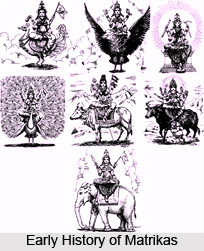 Early history of Matrikas dates back to the first century A.D. The Matrikas function in a group. They possess inauspicious qualities and are considered as dangerous. They play a protective role. The earliest description appears in Mahabharata. In Vana Parva a group of these Goddesses have been mentioned who are known as the mothers of the world. They have been sent by Lord Indra to kill Karthikeya after his birth. However when the child is approached their breast ooze milk and they ask him to adopt them as his mothers.
Early history of Matrikas dates back to the first century A.D. The Matrikas function in a group. They possess inauspicious qualities and are considered as dangerous. They play a protective role. The earliest description appears in Mahabharata. In Vana Parva a group of these Goddesses have been mentioned who are known as the mothers of the world. They have been sent by Lord Indra to kill Karthikeya after his birth. However when the child is approached their breast ooze milk and they ask him to adopt them as his mothers.
One Goddess was born out of anger and carries a spike in her hand. The other Goddess is the daughter of the sea and has a bad temper. When strikes him with thunderbolt several ferocious Goddesses appear. They are: Kaki, Halima, Malini, Brhali, Arya, Palala and Vaimitra. Karthikeya has divided them into good and bad spirits. These mothers were actually the wives of six sages. They were divorced by their husbands for their adulterous nature. As a group of seven mothers they are known as Mahamatrkas. After Karthikeya had adopted them as mothers they had made two requests. Firstly they should be recognized and be worshipped and secondly is to live off the children of men as they have been divorced. Karthikeya disagrees to the second one and instead tells them to protect children to which they agree readily.
These matrikas are characterized by inauspicious qualities. They possess long nails, large teeth, protruding lips. They live in trees, cremation grounds, in caves, in mountains and speak several languages. The references made in Mahabharata make it clear that hese Goddesses were dangerous. Matrikas are attracted to children and it is said that they express their wrathful nature against them.
However the names and number of Matrikas become standardized in the post epic period. The appearance of these seven Goddesses is modified from the Matrikas of the epic. They are patterned on male deities in the medieval period. In mythology they are portrayed as demons who threaten the stability of the universe.
In Devi Mahatmyam one comes to know the best mythological account of them. Demons shumbha and Nishumbha have usurped the throne of the Gods. They fight Devi in the battle. When they approach her the male gods create seven shaktis. These seven shaktis are: Brahmani from Brahma, Mahesvari from lord Shiva, Kaumari from Karthikeya, Vasihnavi from Vishnu, Varahi from the boar avatar of Vishnu, Narasimhi from the man lion incarnation of Vishnu and Aindri from Lord Indra. This group crush the demons. Post battle the seven shaktis dance and are drunk with the blood of the victims.
In Vamana Purana the Matrikas arise from different parts of Devi`s body. In Matsya Purana the Matrikas are created by Shiva in order to fight the demon Andhaka who had the ability to duplicate with a drop of blood. The Matrikas drank the blood of Andhaka.




















